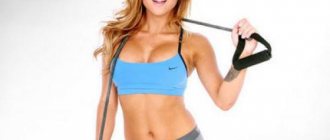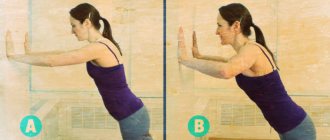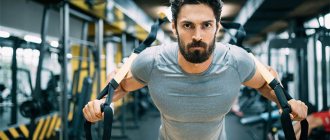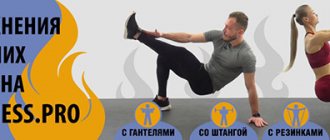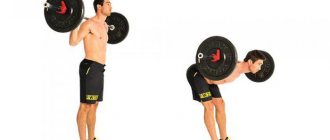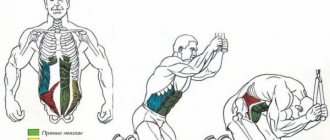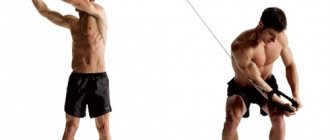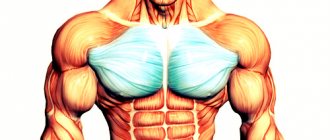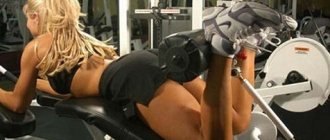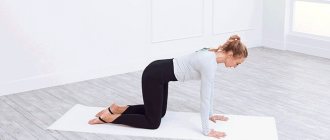It is impossible to achieve an ideal physique without properly selected physical activities. At a minimum, you need to do morning exercises every day. A wide variety of physical exercises have been developed to develop each individual muscle group. One of these is “Melnitsa”, which is well known to everyone since childhood. Physical exercise with additional loads perfectly helps to tighten the body, get rid of excess fat on the sides and form a thin, beautiful waist.
Technique for performing the “Mill”
The main advantage of this physical exercise is the ease of its implementation. The classic version without additional loads is suitable for any category of people. It is often included in a complex of physical exercises for training.
Execution order:
- you need to stand on your feet, straighten your back, your feet should be shoulder-width apart;
- Next, you need to tilt 90 degrees forward, your right arm should be raised up, your left arm should be lowered, and you should also keep your back straight;
- we begin to perform rotational movements with our hands in different directions (when the left hand is at the bottom, you need to reach it to the toe of the right foot, respectively, the right hand to the toe of the left foot);
- We begin to do it slowly, gradually accelerating the pace.
Important! You should not develop a high speed of rotation with your arms if you are doing the exercise for the first time. You should not make sudden movements, and if you suddenly feel dizzy, you need to take a break. It is recommended to first “hone” the correct execution of the physical element, and for a better understanding, watch the training video.
The usual option
The classic technique for performing the “mill” exercise is very simple.
Every person has done it at least once in their life. You need to stand straight, spread your legs slightly wider than your hips, and straighten your knees. For those who have “dry” hamstring muscles, you can place your feet much wider than your shoulders. Straighten your arms and extend them to the sides. Bend your torso parallel to the floor. The body and the front of the thighs should form a right angle.
Then you need to inhale lightly and, exhaling, touch the fingers of your right palm to your left ankle. At this time, the left hand will rise vertically, and its fingers are folded together.
It is very important to keep your knees and back straight while performing the exercise. It is necessary to rotate the body using the abdominal muscles, and not just wave your arms.
To relieve tension from the lower back, you need to tighten the muscles of the buttocks and the back of the thigh. Hand rotations should gradually accelerate.
The effectiveness of video lessons
The ideal place for sports, of course, is a fitness club, equipped with modern and safe sports equipment, and most importantly, under the guidance of a professional instructor. But not everyone can afford to visit a sports complex for various reasons, for example, due to lack of time or limited budget.
Still, despite such reasons, we must not forget about the benefits of playing sports. You can independently figure out the rules for performing physical exercises, in particular with the “Mill,” and do them at home in your free time from work. In this matter, the best assistant is a training video.
At first glance, “The Mill” is a very simple element of physical exercise, but still some nuances are inherent in it. When watching the video, it is recommended to pay attention to the following points:
- correct placement of feet;
- at what angle are rotations performed by the arms;
- the position of the back (it should be straight), knees (they should not be bent);
- movement of the back during training.
It is important to understand! To get rid of fat on the sides, exercise alone is not enough; at the same time, you need to ensure proper nutrition.
Rules for performing the exercise
Initial position:
- Before starting the exercise, the kettlebell stands in front of you, feet shoulder-width apart.
- Through a squat, lift the weight to your shoulder and press it above your head.
- Bend your free arm at the elbow and place it behind your back.
- The gaze is directed forward.
Position 1:
- Holding the kettlebell at arm's length, push your pelvis toward your working arm.
- Turn the foot you will be leaning towards 45 degrees. T
- Now bend your torso until it is parallel to the floor or as far as you can.
- The working hand remains in its original position. As you move, look at the weight.
End position:
- Slowly return your body to the starting position, making sure that the weight always remains vertically upward.
- The gaze is directed forward. This is your starting position
Repeat the “mill” as many times as necessary. Watch the technique of performing the exercise. A variation could be a “mill” without weights.
"Mill" with additional load
There are many options to complicate the exercise, but before increasing the load, especially on the back, it is recommended to carefully study and work on the classic method. Otherwise, you may not see results, while also harming your own health.
Mill with weight
A complicated version of the “Mill” exercise, which is intended for strength training. Develops the strength and flexibility of the athlete.
Execution rules:
- The weight must be thrown over the shoulder and pushed up.
- Then move the thigh to the side corresponding to the hand with the kettlebell. So, if the weight is in the right hand, then you need to point your right hip to the right side.
- Next, you need to inhale, while exhaling, bend along the leg opposite the hand with the weight, while keeping your back straight. With your free hand you need to reach the toe, sliding down this leg.
This strength exercise is done in 5-7 approaches, for beginners three is enough.
Mill on one leg
The “Mill” exercise becomes much more difficult when performed on one leg. This option helps not only to form a spectacular waist, but also to strengthen the muscle mass of the legs, develop endurance, and learn to maintain balance.
Important! Beginners are advised to initially perform this exercise slowly.
Classic "mill"
This option has been familiar to everyone since childhood, when we did it in physical education lessons. From a standing position, bend over so that your chest and stomach are parallel to the floor. The angle between the legs and the stomach is 90 degrees. This is very important so that there is no additional stress on the back, especially when weighted with kettlebells. We place our feet at a distance slightly greater than shoulder width. If you cannot keep your legs straight, then spread them even wider.
We spread our arms to the sides, pressing our fingers together. We inhale, as we exhale we touch our left leg with our right hand, inhale backward, exhale – our left hand touches our right leg. The free hand looks up. The exercise should be done calmly, without rushing. The main thing is to ensure that your legs do not bend, that your back remains straight, that your arms are straight and strong. Please note that movements are carried out only by contracting the lateral abdominal muscles.
Arms, legs and buttocks will be effectively worked and stretched if you tense them. This means that the body should be “taut like a string.” Then such a simple exercise will be useful in all directions. When you feel tired, return to the starting position. After resting, we proceed to the next approach. There should not be more than two of them, but include approaches of 8-10 touches on each side.
Conclusion
“Mill” is a simple, yet effective physical exercise that can be performed at home, for example, during morning exercises. But at the same time , you need to understand that all sports exercises give the desired result in combination, subject to proper nutrition.
Therefore, before you start playing sports on your own, it is recommended to consult with a professional sports trainer who will help you choose the optimal physical activity program for you. Only after this can you start working on your body! Exercise mill
Muscles involved in the exercise
Let's take a look together at what muscle groups work when doing the “mill” with a kettlebell. The main muscle group involved in the work is the abs (rectus, transverse and oblique).
Accessory muscles are also involved. Among them are the shoulder girdle, buttocks (small and middle), hips (posterior surface, adductors and infraspinatus).
The main focus is on the press. When lifting, the emphasis shifts to the lower torso (lower back, buttocks and thighs). During lowering, the shoulder girdle and triceps are involved in the work.
Mill exercise: how to do it right
Good afternoon I have a question about light physical activity: does the “Mill” exercise promote weight loss or is it ineffective? I’m going to the sea soon, and there are wrinkles on the sides; I want to wear an open swimsuit, but I’m embarrassed. I decided to lose a couple of kilograms.
I’m not keen on diets because they have a bad effect on my gastritis. I decided to resort to sports, and since since school physical education I like this kind of simple exercise the most, I decided to use it in the fight for the beauty of the body.
Please advise someone who knows how to perform it correctly and whether it is effective in the fight against hated sides. Thank you in advance for your help and understanding.
In the fight against fatty tissue deposits on the sides, the “Mill” exercise can be a very good helper. Its action is aimed at working out the waist. When performing this type of physical activity, many muscle groups are involved and, unlike strength exercises, there is no monotonous effect on a specific muscle. Therefore, after playing sports there is no feeling of fatigue, pain and exhaustion.
The “Mill” exercise trains the abdominal muscles, lateral muscles, and strengthens the back. As a result of regular moderate exercise, you can get a toned stomach, a thin waist and a healthy back, which will transform your posture. In order not to harm your health, you should perform this exercise correctly:
- the legs should be shoulder-width apart, resting on the floor with the entire foot, so that the student does not drift to the side during exercise and is not injured;
- arms should be spread to the sides, the torso should be tilted perpendicular to the floor;
- the exercise begins with rotational movements of the torso from side to side, while one hand should reach to the toe of the opposite leg, and the other should be raised above the head;
- the arms do not bend during the execution; they should form a single straight line.
The main thing to remember when performing this type of physical exercise is that you need to start it smoothly, carefully, and develop the speed gradually. After all, unheated or untrained muscles and ligaments can be easily pulled.
What else to read?
{amp}gt; Exercises{amp}gt; How to do the physical exercise Mill correctly
It is impossible to achieve an ideal physique without properly selected physical activities. At a minimum, you need to do morning exercises every day.
A wide variety of physical exercises have been developed to develop each individual muscle group. One of these is “Melnitsa”, which is well known to everyone since childhood.
Physical exercise with additional loads perfectly helps to tighten the body, get rid of excess fat on the sides and form a thin, beautiful waist.
The “Mill” exercise is quite simple to do.
Place your feet shoulder-width apart, tilt your body forward at a right angle, parallel to the floor. Stretch your arms to the side, in the same plane as your torso, parallel to the floor.
Now turn your body first to the right, then to the left, so that your hands are perpendicular to the floor each time. The arms should remain motionless at the shoulders, the entire body moves completely. In this position, do 20-30 repetitions.
Here you will find additional exercises for the waist that help effectively combat fat deposits on the sides and abdomen.
Helpful advice
Remember, the best exercise for getting rid of belly fat is… vigorously turning your head left and right, every time you are offered to eat :)))
Here are a couple more exercises for shaping your waist from the sides in the video.
The “mill” exercise does not require much time or special physical abilities. It will allow
Important!
In the fight against fatty tissue deposits on the sides, the “Mill” exercise can be a very good helper. Its action is aimed at working out the waist. When performing this type of physical activity, many muscle groups are involved and, unlike strength exercises, there is no monotonous effect on a specific muscle. Therefore, after playing sports there is no feeling of fatigue, pain and exhaustion.
What else to read?
Execution Rules
The most important thing in performing any exercise is technique. Only with proper execution can you achieve the desired result.
So, how to correctly perform the “Mill” exercise. The optimal procedure looks like this:
- Stand on your full foot, without shifting your center of gravity.
- Place your feet at a width equal to shoulder width.
- Lean forward so that your body is parallel to the floor.
- Extend your arms straight out in opposite directions.
- Inhale, then, as you exhale, touch the toe of your left foot with your right hand.
- Inhale again, and while exhaling, change position - left hand to the toe of the right foot. In this case, the free hand should always form a straight line with the other and point upward.
The pace and rhythm are set individually by each person. It depends on physical fitness, capabilities and individual characteristics.
However, during the execution process it is important to follow a number of rules:
- Be sure to keep your back straight. This is the only way to create the correct load on the muscles;
- breathe evenly and constantly. Do not stop breathing, as proper oxygen supply guarantees optimal fat burning;
- legs cannot be bent;
- perform movements with the strength of the lateral and abdominal muscles, and not by swinging your arms;
- Tighten your stomach and tighten your buttocks as well as your legs. This will allow you to use additional muscle groups.
To perform any exercise or complex, the correct approach is required. However, mistakes are often made precisely in the technique of the exercise, which greatly reduces its effectiveness.
The most common are:
- bending the legs, lack of tension in them;
- back bending. It must be straight;
- the rhythm is too fast. The exercise must be worked through, and this requires a moderate rhythm;
- rotation due to the swing of the arms. This mistake completely destroys the entire positive effect of the exercise.
Thus, it is very important to observe the correct execution of the “Mill”, otherwise there will be no sense in it, and all the conditions will come to naught.
The ideal female body cannot be imagined without a chiseled, thin waist. Therefore, no matter how much you pump up your abs, without hard work on the internal oblique abdominal muscles, you will not have an ideal waist. There are several types of special exercises for working the lateral abdominal muscles: backbends, various twists, lateral leg raises, mill, etc. Today we will look at the “Mill” exercise. It should be noted that this type of load has several implementation options, each of which will work a separate muscle group.
Alternative Exercises
“Mill” with a weight without weights. In this exercise you do the same thing, only without weights. This exercise is performed in order to understand the technique of execution and get used to it, and then proceed to the “mill” with weights.
Turns with a disc from a barbell. The exercise is performed sitting on the floor, legs straight. Hold the plate with both hands at abdominal level, arms slightly bent. Cross your legs at the ankles and lift them, knees slightly bent. As you exhale, turn the plate to the left and touch it to the floor.
Russian crunches with weights
Weighted crunches. In this exercise, the load is concentrated on the abdominal muscles. Performed while lying on the floor. Bend your legs at a 90-degree angle, holding your weight at chest level or with your arms extended above your torso. Start contracting your abdominal muscles. It is important to work with the abs, and not with other muscles.
Weighted crunches
Side bends with dumbbells. The exercise is aimed at developing the abdominal muscles. Stand up straight, take a dumbbell in one hand, and place the other on your belt. Bend at the waist, pause and return to the starting position. Switch hands. You can also perform this exercise with a kettlebell or barbell.
Side bends with dumbbells
Standards and number of approaches
To achieve the desired effect, it is necessary to perform a certain number of approaches and repetitions. So, for the classic “mill” and other complicated variants, the minimum number of repetitions is 15. Moreover, movements to the right and left are counted as one.
You can start performing the number of approaches from 3. Further, both repetitions and approaches can be increased.
For the “Mill” with a kettlebell at the first stage, 5-6 repetitions with 3 approaches are enough. However, if preparation allows, you can start with more times.
As a result, the “Mill” exercise significantly helps improve your figure and health. This exercise perfectly shapes the waist and removes fat from the sides.
However, if done correctly, you can also use other muscles in the body. If you follow the technique and eliminate mistakes, the effectiveness of such a simple exercise is maximum.
Suitable for whom and when?
Potentially, everyone should do the mill exercise, as it is an effective element of training or warm-up. However, the movement will be most useful in the following cases:
- To maintain muscle tone.
- When training at home.
- To compensate for the negative impact of a sedentary lifestyle on the spine.
- For strength training without regular aerobic training (preventing constipation).
- As exercise or warm-up.
Provided that the athlete does the mill correctly, the movement can be recommended to absolutely everyone, except in cases where it is necessary to exclude or limit physical activity.
Complicating the exercise
To progress, you can use the following methods:
When using weights, the muscle load is partially redistributed. In a mill with a weight, the muscles not only work in the back and abs, which lead the body to rotation, but also the arms and shoulders are actively loaded. However, the most convenient equipment is considered to be a dumbbell that can be held firmly in your hand. Unlike a kettlebell, it does not increase inertia during rotation, which is why it is considered more suitable and convenient.
